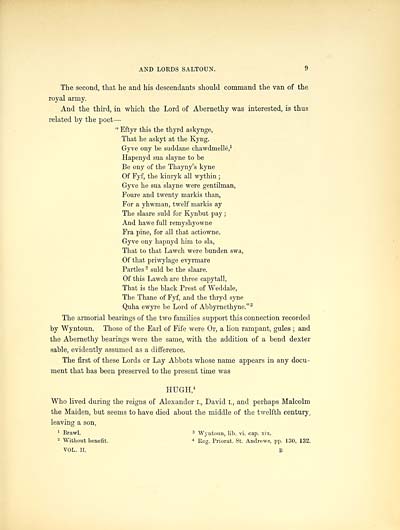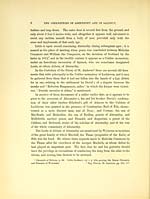Frasers of Philorth > Volume 2
(23)
Download files
Complete book:
Individual page:
Thumbnail gallery: Grid view | List view

AND LORDS SALTOUN. 9
The second, that he and his descendants should command the van of the
royal army.
And the third, in which the Lord of Abernethy was interested, is thus
related by the poet —
" Eftyr this the thyrd askynge,
That he askyt at the Kyng.
Gyve ony be suddane chawdmelle, 1
Hapenyd sua slayne to be
Be ony of the Thayny's kyne
Of Fyf, the kinryk all wythin ;
Gyve he sua slayne were gentilman,
Foure and twenty markis than,
For a yhwman, twelf markis ay
The slaare suld for Kynbut pay ;
And hawe full remyshyowne
Fra pine, for all that actiowne.
Gyve ony hapnyd him to sla,
That to that Lawch were bunden swa,
Of that priwylage evyrmare
Parties 2 suld be the slaare.
Of this Lawch are three capytall,
That is the black Prest of Weddale,
The Thane of Fyf, and the thryd syne
Quha ewyre be Lord of Abbyrnethyne." 3
The armorial bearings of the two families support this connection recorded
by Wyntoun. Those of the Earl of Fife were Or, a lion rampant, gules ; and
the Abernethy bearings were the same, with the addition of a bend dexter
sable, evidently assumed as a difference.
The first of these Lords or Lay Abbots whose name appears in any docu-
ment that has been preserved to the present time was
HUGH, 4
Who lived during the reigns of Alexander I., David I., and perhaps Malcolm
the Maiden, but seems to have died about the middle of the twelfth century,
leaving a son,
1 Brawl. 3 Wyntoun, lib. vi. cap. xix.
2 Without benefit. 4 Reg. Priorat. St. Andrews, pp. 130, 132.
VOL. II. B
The second, that he and his descendants should command the van of the
royal army.
And the third, in which the Lord of Abernethy was interested, is thus
related by the poet —
" Eftyr this the thyrd askynge,
That he askyt at the Kyng.
Gyve ony be suddane chawdmelle, 1
Hapenyd sua slayne to be
Be ony of the Thayny's kyne
Of Fyf, the kinryk all wythin ;
Gyve he sua slayne were gentilman,
Foure and twenty markis than,
For a yhwman, twelf markis ay
The slaare suld for Kynbut pay ;
And hawe full remyshyowne
Fra pine, for all that actiowne.
Gyve ony hapnyd him to sla,
That to that Lawch were bunden swa,
Of that priwylage evyrmare
Parties 2 suld be the slaare.
Of this Lawch are three capytall,
That is the black Prest of Weddale,
The Thane of Fyf, and the thryd syne
Quha ewyre be Lord of Abbyrnethyne." 3
The armorial bearings of the two families support this connection recorded
by Wyntoun. Those of the Earl of Fife were Or, a lion rampant, gules ; and
the Abernethy bearings were the same, with the addition of a bend dexter
sable, evidently assumed as a difference.
The first of these Lords or Lay Abbots whose name appears in any docu-
ment that has been preserved to the present time was
HUGH, 4
Who lived during the reigns of Alexander I., David I., and perhaps Malcolm
the Maiden, but seems to have died about the middle of the twelfth century,
leaving a son,
1 Brawl. 3 Wyntoun, lib. vi. cap. xix.
2 Without benefit. 4 Reg. Priorat. St. Andrews, pp. 130, 132.
VOL. II. B
Set display mode to:
![]() Universal Viewer |
Universal Viewer | ![]() Mirador |
Large image | Transcription
Mirador |
Large image | Transcription
Images and transcriptions on this page, including medium image downloads, may be used under the Creative Commons Attribution 4.0 International Licence unless otherwise stated. ![]()
| Histories of Scottish families > Frasers of Philorth > Volume 2 > (23) |
|---|
| Permanent URL | https://digital.nls.uk/96570532 |
|---|
| Attribution and copyright: |
|
|---|---|
| Description | A selection of almost 400 printed items relating to the history of Scottish families, mostly dating from the 19th and early 20th centuries. Includes memoirs, genealogies and clan histories, with a few produced by emigrant families. The earliest family history goes back to AD 916. |
|---|

